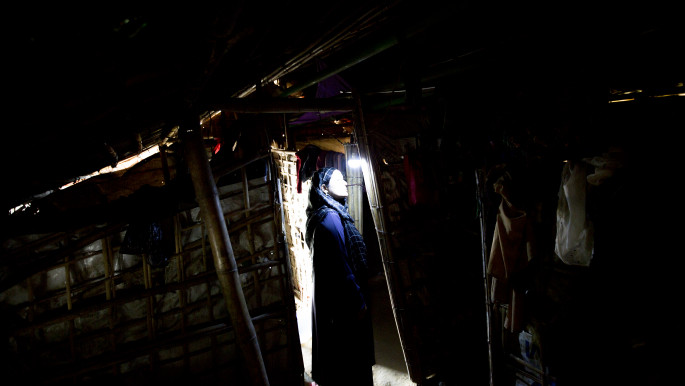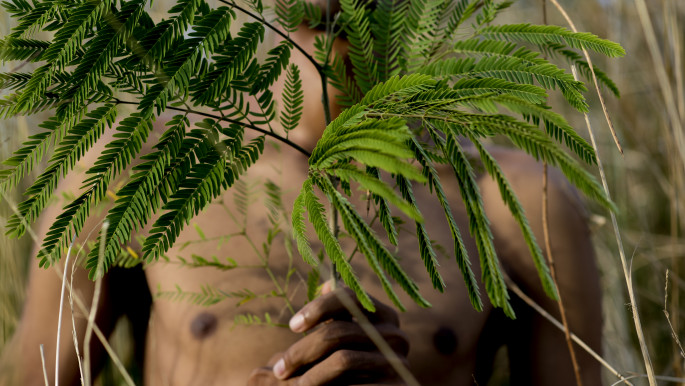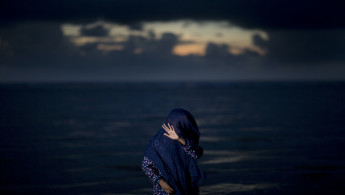The Torture in My Mind: Powerful photographs depict the Rohingya mental health crisis
"Monuwara", a Rohingya refugee in Bangladesh, is airing her dissatisfaction, not to complain, but as part of a powerful photo essay by Saiful Huq Omi.
The Dhaka-based award winning photographer portrayed members of a research team in Cox's Bazar who were fundamental to a recent report documenting an overwhelming mental health crisis among the displaced population.
With this project Omi took a different approach and asked his 'subjects' how they would like to be photographed.
"I just wish I had a house that is less hot inside, more windows, bigger rooms and, above all, I wish I had more light in my house. I want you to go with me and photograph me in that darkness," requested "Monuwara."
The report entitled The Torture in My Mind, published by Fortify Rights, put together quantitative data from the refugee camps of Cox's Bazar, in southeastern Bangladesh, recording symptoms of mental harm that included post-traumatic stress disorder (PTSD), depression and anxiety.
After any emergency situation, the UN estimates around 15 to 20 percent of adults experience some form of mental health disorder.
The Bangkok-based human rights organisation found, however, that 88.7 percent of Rohingya refugees experienced depression and 84 percent experienced emotional distress, while 61.2 percent experienced PTSD symptoms, which in all were adversely impacting the daily lives of survivors.
 |
|
| "Monuwara": Credit: ©Saiful Huq Omi/Counter Foto for Fortify Rights |
The Rohingya, a predominantly Muslim ethnic group that have resided in Myanmar's Rakhine state since the 12th century, have been subject to a deadly crackdown that a UN fact-finding mission described as an ongoing genocide.
In 2017, military action on Rohingya populations led to thousands killed and around 700,000 fleeing to Bangladesh. To date, there has been no accountability for the crimes.
In addition to data collection — conducted and shaped by 10 Rohingya who carried out 495 household surveys, 13 pre-research focus-groups, 33 feedback sessions, and 16 community workshops — eight of the researchers participated in Omi's project.
"Abdul", having seen a logo with human hands of a peace-keeping organisation he assumed was part of the UN, wanted to be represented as a peace-loving man.
"I am tired here," he says, "I want to go back… Please do not show my face. Show my hands... I will imitate the logo."
 |
|
| "Abdul": Credit: ©Saiful Huq Omi/Counter Foto for Fortify Rights |
Sama asked to be photographed while working as a therapist. Having lost so much herself, she says, "When they talk, when they give vent to their feelings, then they feel so much better, and I feel better too… They have experienced so much trauma, so much trauma."
Speaking to The New Arab, Omi said, "The moment I was commissioned by Fortify Rights, I began to think how I could make my work participatory in nature. Photography as a practice of art is sometimes quite like 'extraction'. I began to think how not to be a mere observer or go beyond 'stealing' a moment from someone's life."
It was also a way of making this particular series stand out from his 12-year body of work documenting and depicting the experiences of the population.
The participants, after initial shock, embraced the idea of choosing their photographs' context, stretching their imaginations and even providing their technical input on composition.
The process, says Omi, helped him relearn about building trust and respecting the 'subject'.
"Mg Khin Soe" did not want to hide knowing he had not done much wrong in life. "I would be happy to be photographed in the bushes, in the forest, as I love the green so much," he said, "I know a place, next to the graveyards."
 |
|
| "Mg Khin Soe": Credit: ©Saiful Huq Omi/Counter Foto for Fortify Rights |
"Jasim Arkane" wanted to be photographed where you could see the endless camps. "I want to show the world how big this place is and how many of us are here. I want to speak to the world of what they have done to me," he said.
 |
I want to show the world how big this place is and how many of us are here. I want to speak to the world of what they have done to me |  |
"Once I got to know more about the reality on the ground [and] the genocide, I simply felt I could not leave," said Omi, whose own interest in the Rohingya grew in 2008 after meeting the Dutch ambassador who suggested visiting the camps. He had no idea he would then spend the following years committed to the Rohingyas' story, he told The New Arab.
At the time, says Omi, he was the only Bangladeshi photographer focusing on the Rohingyas' plight and eventually started providing research, reporting, production, film and advocacy input to various organisations to tell their story.
"I started to photograph them because I felt they deserve justice and photographs could play a role to ensure justice for them," he said. "Naively I thought I could play a role 'stopping' the genocide," he confessed, but bouts of violence ensued in 2012, 2016 and 2017.
"Sumaya Bibi" wants to use the small space next to her shelter to teach Rohingya children in lieu of formal schools in the camp. "I am, in particular, very proud of my husband. He has always protected and supported me in all of my work," she said, asking Omi to depict him extending his support.
One 40-year-old Rohingya woman, Fortify Rights reported, said, "When I try to sleep, I imagine what the military and Buddhists have done to me."
According to Fortify Rights, among the most reported symptoms experienced by Rohingya refugees in Bangladesh is the reliving of traumatic events. Almost all — 97.6 percent — Rohingya refugees experienced recurrent memories, whether having the feeling of those events happening again or by experiencing nightmares.
"I feel like they are coming, chasing, and shooting me. I think of how they hacked and killed people and threw children on the fires. When I am in bed, the imagination of the torture appears in my mind," one refugee recalled.
 |
I feel like they are coming, chasing, and shooting me. I think of how they hacked and killed people and threw children on the fires. When I am in bed, the imagination of the torture appears in my mind |  |
Traumatic experiences among the participants included witnessing frequent gunfire, the destruction or burning of villages, dead bodies and physical violence against or murder of others.
A large degree of those interviewed were also physically harmed and around a third of men and women had experienced sexual abuse; some had been raped.
More than two-thirds of the refugees spoken to also said they felt "humiliated or subhuman", contributing to their deteriorating mental-health.
"They treated us worse than animals," said one participant to the research team about Myanmar authorities. "They considered and counted us like animals. They put people inside houses, locked the door, and burned the houses and the people as well. Would anyone do that to an animal?"
One of the impacts to refugees has been that even daily activities have become hard, 91.3 percent of Rohingya refugees saying that common daily activities were difficult in some regard, whether that was maintaining hygiene standards or participating in social and religious acts, for example, with 62.3 percent seeing their declining mental health as the reason for these challenges.
 |
They treated us worse than animals... They put people inside houses, locked the door, and burned the houses and the people as well. Would anyone do that to an animal? |  |
"Rafiqul" took Omi to see the Bangladesh-Myanmar border, several minutes from his camp. "I want you to show me where I am from, where everything happened… just do not show my face. I am so afraid even though I am staying here," he said.
 |
|
| "Rafiqul": Credit: ©Saiful Huq Omi/Counter Foto for Fortify Rights |
"Fatima" loves the sea, looking at it when she comes back from work. She wanted to take a pause one day to be photographed by the sea. "I will wear something beautiful. Maybe a blue? Matched with the colour of the sea. Just do not show my face," she said.
 |
|
| "Fatima" : Credit: ©Saiful Huq Omi/Counter Foto for Fortify Rights |
A history of systemic human rights violations against the Rohingya is an important factor driving mental health distress among the Rohingya, said Andrew Riley, a research consultant with Fortify Rights, speaking to The New Arab.
"The Rohingya disproportionately have experienced ubiquitous human rights violations, high rates of violence, and difficult living conditions; these lead to widespread and extreme levels of long-term distress among Rohingya."
While a mental health crisis is typically looked at through a public health lens, Riley says that the organisation's research has shown that often the symptoms of mental health distress is treated while the causes — continuing human rights abuses — go unaddressed.
"Ensuring justice and accountability is an attempt to address these problems at their core, the deprivation of Rohingya rights," he says.
The international community has generally improved in looking at mental health services as part of humanitarian response although it remains a challenging area of provision, says Riley. On the other hand, more advocacy is needed to "change the complex political realities that underpin human rights violations and lead to extreme levels of mental harm."
"This is an area that needs urgent prioritisation, because the status quo of these rights violations and daily living conditions is continuing to cause long-term harm to persecuted and marginalised populations," he added.
Fortify Rights detail a range of recommendations in their report, to the Governments of Myanmar and Bangladesh, the UN and the international community. Ultimately, however, the human right to mental health for Rohingya is "inextricably linked to ensuring justice and accountability", it states.
Each actor must do their part, says the organisation, to ensure accountability and redress the harm caused by mental health distress of the Rohingya.
Omi adds that the photographer has the ability in such emergency situations to do good, reporting truths, while also being able to cause harm if they do not approach their task correctly.
"One needs to decide which part of history they would like to be on," he concludes.
Sophia Akram is a researcher and communications professional with a special interest in human rights particularly across the Middle East.
Follow her on Twitter: @mssophiaakram



